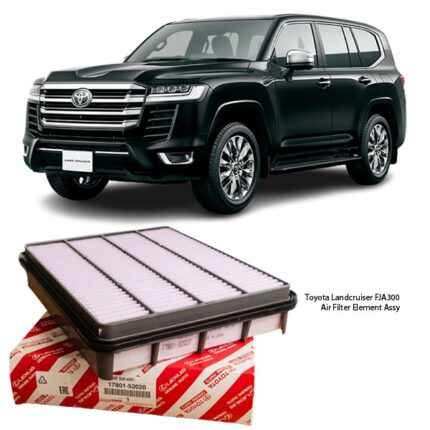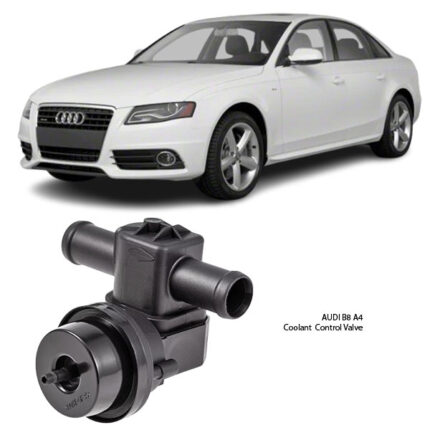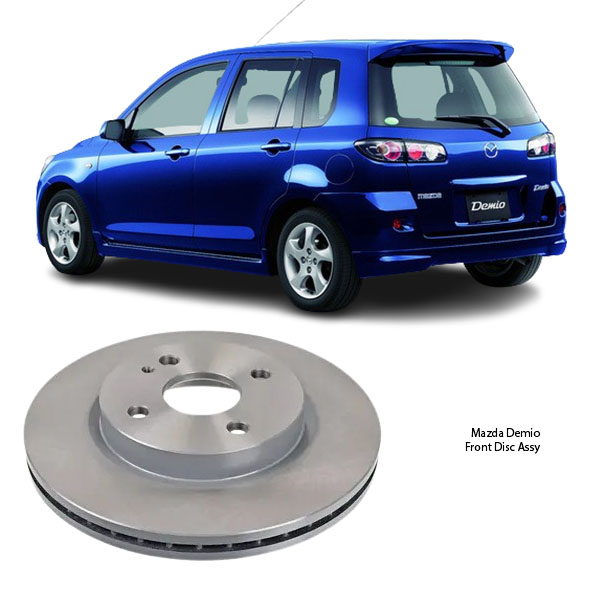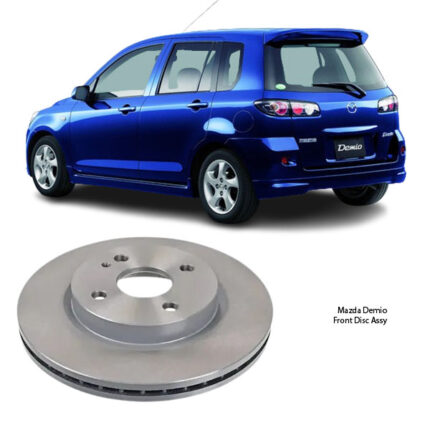-9%
Get Mazda Demio Front Brake Disc Assy D35Y-33-25XC in Kenya
The Front Brake Disc Assembly is one of the most critical components in a vehicle’s braking system. It ensures effective stopping power, stability, and safety while driving. Whether you’re a car enthusiast , a mechanic , or just a curious driver , this guide will break down everything you need to know about front brake disc assemblies in 1000 words.
1. What is a Front Brake Disc Assembly?
A front brake disc assembly consists of components that work together to slow down or stop a vehicle by using friction. The assembly primarily includes:
Key Components of a Front Brake Disc Assembly
Brake Disc (Rotor) – A circular metal disc attached to the wheel hub that rotates with the wheel.
Brake Pads – Friction materials that press against the brake disc to slow down the vehicle.
Brake Caliper – A housing unit that holds the brake pads and squeezes them onto the disc.
Brake Fluid – Hydraulic fluid that transfers force from the brake pedal to the calipers.
Brake Lines & Hoses – Carry brake fluid to and from the calipers.
Wheel Hub – Connects the disc to the wheel and allows it to rotate.
2. How Does a Front Brake Disc Assembly Work?
The front brake disc assembly functions through a hydraulic braking system. Here’s a step-by-step breakdown:
Pressing the Brake Pedal
When the driver presses the brake pedal, hydraulic pressure is created in the master cylinder.
Transmission of Pressure
The hydraulic fluid transmits pressure through brake lines to the calipers.
Brake Pad Engagement
The caliper squeezes the brake pads against the spinning brake disc.
Friction & Heat Generation
The friction between the brake pads and the disc converts kinetic energy into heat, slowing the wheel.
Vehicle Stops or Slows Down
The more pressure applied, the stronger the braking force, bringing the car to a stop.
3. Types of Front Brake Discs
Different brake disc designs are used depending on driving needs and performance.
1. Solid Brake Discs
- A simple, flat metal disc.
- Found in economy and older vehicles.
- Affordable but can overheat quickly.
2. Vented Brake Discs
- Has internal cooling channels to dissipate heat.
- Common in most modern cars.
- Prevents overheating and brake fade.
3. Drilled Brake Discs
- Features holes for better heat dissipation.
- Used in performance and racing cars.
- Reduces brake fading but can weaken over time.
4. Slotted Brake Discs
- Has grooves to remove debris and heat.
- Increases stopping power and grip.
- Best for heavy-duty and off-road use.
5. Drilled & Slotted Discs
- A combination of both for high performance.
- Provides excellent cooling and braking power.
- Ideal for sports and high-speed cars.
4. Types of Brake Pads Used in the Assembly
Organic Pads (NAO – Non-Asbestos Organic) – Quiet, affordable, but wears out quickly.
Semi-Metallic Pads – Durable and heat-resistant, ideal for everyday use.
Ceramic Pads – Best performance, long lifespan, but expensive.
Low-Metallic Pads – A mix of metal and organic for balanced performance.
Choosing the right brake pad is crucial for maintaining stopping power and reducing wear.
5. Signs of a Worn-Out Front Brake Disc Assembly
A failing brake disc assembly can be dangerous. Look for these warning signs:
Squealing or Grinding Noise – Worn-out brake pads scraping the disc.
Vibrations or Pulsation in the Brake Pedal – Warped or uneven brake discs.
Longer Stopping Distance – Reduced braking efficiency.
Visible Cracks or Grooves on the Disc – Excessive wear or overheating.
Burning Smell – Overheated brakes from excessive friction.
Ignoring these signs can lead to brake failure!
6. Benefits of a Good Front Brake Disc Assembly
Enhanced Safety – Reliable stopping power prevents accidents.
Better Heat Dissipation – Reduces brake fade and overheating.
Smoother Braking – No vibrations or noise.
Increased Brake Pad Lifespan – Reduces wear and tear.
Improved Fuel Efficiency – Less rolling resistance means better mileage.
A well-maintained brake disc system keeps your car safe and efficient!
7. How to Replace a Front Brake Disc Assembly
Replacing front brake discs is a medium-level DIY task but should be done with caution.
Tools Required :
Jack & Jack Stands
Wrench Set & Ratchet
Brake Cleaner & Lubricant
C-Clamp or Brake Caliper Tool
New Brake Disc & Pads
Step-by-Step Process:
Lift the Car & Remove the Wheel – Secure the vehicle and loosen lug nuts.
Remove the Brake Caliper – Unbolt and hang it safely to avoid stressing the brake line.
Take Out the Old Brake Disc – If stuck, gently tap with a mallet.
Clean the Hub & Install the New Disc – Ensure a smooth surface for even contact.
Reattach the Caliper & Brake Pads – Ensure proper alignment.
Refit the Wheel & Test the Brakes – Lower the car and perform a test drive.
Tip: Always replace brake discs in pairs (left & right) to maintain balanced braking.
8. Maintenance Tips for Front Brake Disc Assemblies
Check Brake Fluid Levels – Low fluid can reduce braking power.
Inspect Discs & Pads Regularly – Every 10,000-15,000 miles.
Avoid Sudden Braking – Increases wear and overheating.
Allow Brakes to Cool Down – Avoid hard braking in long drives.
Use Quality Parts – Invest in high-quality brake discs and pads.
Proper maintenance prolongs the life of your braking system and ensures safety!
9. Choosing the Right Front Brake Disc Assembly for Your Vehicle
When selecting a brake disc assembly, consider:
Driving Style – Daily commuting, off-roading, or performance racing.
Vehicle Type – Compact cars, SUVs, or sports cars require different discs.
Brake Pad Compatibility – Ensure the disc matches your brake pads.
Material & Brand – Go for high-quality steel or carbon-ceramic options.
Budget – High-performance discs cost more but offer better durability.
Investing in the right brake system ensures optimal safety and performance.
Conclusion
The Front Brake Disc Assembly is a vital component for vehicle safety and performance. Understanding its function, types, maintenance, and replacement helps in making informed decisions for better braking efficiency.
Stay Safe & Drive Smart!
Follow us on Facebook for more parts.




